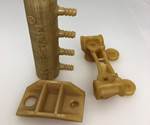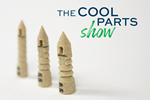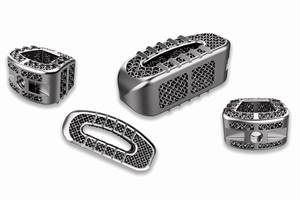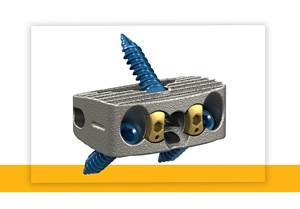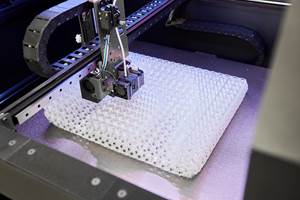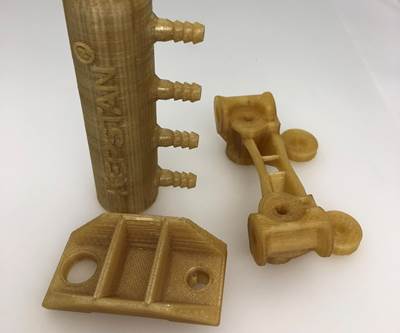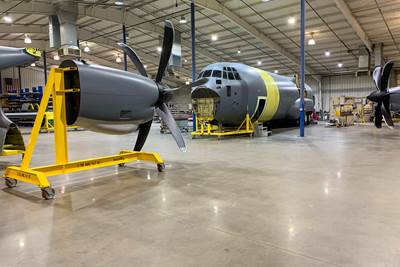Polyether ether ketone (PEEK) is used in medical implants for its modulus akin to human bone as well as its radiolucence, giving physicians a clear view of a healing injury via X-ray. Implants made from this material until now have mostly been molded or machined, in part because of the challenges of 3D printing PEEK. The large delta between the material’s glass transition and melting temperatures makes the polymer tricky to apply with standard fused filament fabrication (FFF). Curiteva instead uses a novel 3D printing method called fused strand deposition (FSD), which does not fully melt the filament and actually pulls the material along as it is being deposited. The company has achieved FDA approval and is now in production for its first 3D printed PEEK implant, the cervical spine cage featured in this episode. | This episode of The Cool Parts Show is brought to you by Carpenter Additive
The Cool Parts Show is a video series from Additive Manufacturing Media that explores the what, how and why of unusual 3D printed parts. Watch more here.
Have a cool part to share? Email us.
Related Resources
-
Updated April 2024: Curiteva has FDA clearance for the cervical and lower lumbar implants, including cervical
-
PLIF - Posterior Lumbar Interbody Fusion
-
TLIF - Transforaminal Lumbar Interbody Fusion
-
ALIF - Anterior Lumbar Interbody Fusion
-
OLIF - Oblique Lateral Interbody Fusion
-
DLIF - Direct Lateral Interbody Fusion
-
- Curiteva’s PEEK filament is derived from Vestakeep produced by Evonik, which also assisted Curiteva during the FDA approval process
- Another episode on a medical implant made from polymer (in this case, PEKK applied with selective laser sintering)
- How to think about 3D printing with high-performance polymers like PEEK
Transcript
00:00:00:02 - 00:00:00:14
Pete Zelinski
I'm Pete.
00:00:01:01 - 00:00:05:17
Stephanie Hendrixson
I'm Stephanie. And this is The Cool Parts Show, our show all about innovative unique 3D printed parts.
00:00:06:04 - 00:00:13:00
Pete Zelinski
This is a 3D printed spine implant made of polymer, not metal, and it's been approved by the FDA.
00:00:13:09 - 00:00:18:18
Stephanie Hendrixson
It's also our first implant to be featured on the show that is made through an extrusion style 3D printing process.
00:00:19:11 - 00:00:24:17
Pete Zelinski
Fused Strand Deposition of PEEK on this episode of The Cool Parts Show.
00:00:30:20 - 00:00:34:03
Stephanie Hendrixson
This episode of The Cool Parts Show is brought to you by Carpenter Additive.
00:00:34:03 - 00:00:37:11
Pete Zelinski
We're at the company's powder production facility in Athens, Alabama.
00:00:37:13 - 00:00:43:13
Stephanie Hendrixson
Specifically, we are standing on top of the Z1, the company's largest vacuum atomizer for producing metal powders.
00:00:43:19 - 00:00:50:06
Pete Zelinski
Want to know how to make metal powder for additive manufacturing? Stick around after the episode. Welcome to The Cool Parts Show.
00:00:50:13 - 00:01:05:18
Stephanie Hendrixson
Thank you for joining us. If you like the show, hit that subscribe button to get notified about our new episodes. Today, we're going to be talking about this 3D printed cervical spine implant. This is an FDA approved device and it's made from PEEK, polyetheretherketone. So in other words, it's a polymer.
00:01:06:07 - 00:01:35:06
Pete Zelinski
We have covered 3D printed spine implants in articles on AdditiveManufacturing.media, even on The Cool Parts Show. But those 3D printed implants have been made of metal, made of titanium and produced through powder bed fusion. This spine implant tells a very different story. This is a polymer and it was made through a different process. It was made through a deposition style 3D printing process, a variation on fused filament fabrication.
00:01:35:20 - 00:01:57:20
Stephanie Hendrixson
So different process, different material. And the exact material is important here too. So PEEK is a semi crystalline polymer. It's a thermoplastic so you can heat it up, mold it, print it, manipulate it in various different ways. But as it cools, it forms this crystalline microstructure that gives it some interesting material properties. So to talk about why PEEK is so good for implants in particular, I want to introduce Todd Reith.
00:01:57:20 - 00:02:04:11
Stephanie Hendrixson
Todd is the Vice President of Emergent Technologies and Additive Manufacturing at Curiteva, which is the company that makes these implants.
00:02:04:20 - 00:02:32:15
Todd Reith
PEEK has a long history of being used for implants. It's a safe and biocompatible material used for over 30 years. The material is radiolucent, surgeons can precisely monitor the patient post-op. The implant is totally transparent in x-rays, making it possible to see the bone integrate with the implant. The modulus is nearly 1 to 1 to human bone, and the implant bears the weight like natural bone, which reduces the likelihood of adjacent stress shielding.
00:02:33:19 - 00:02:56:08
Pete Zelinski
So PEEK has great properties. It has stiffness that matches that of human bone. It is radiolucent, meaning it's invisible to X-rays. But there are challenges, starting here. PEEK is not a bioactive material. Curiteva had to deal with that. To talk about that here is Curiteva’s Erik Erbe, who is chief science officer.
00:02:56:23 - 00:03:43:18
Erik Erbe
The PEEK material is traditionally hydrophobic, meaning it repels, is not loving of water. To make it hydrophilic, one of the things we've done is to apply a nano coating of hydroxyapatite. This becomes important because this is done after we print the part. So it gets on every surface, every interstices, up in every single pore, that liquid is evaporated off and then nano crystals of hydroxyapatite with the needle like morphology are adhered very strongly to the surface of the implant inside and out all throughout. These nano hydroxyapatite crystals not only makes it hydrophilic, but drives a reaction that forms bone that is known as immunomodulation.
00:03:44:10 - 00:03:55:14
Stephanie Hendrixson
So that coating is the way that Curiteva got around PEEKs hydrophobic properties. But there are some other hurdles to clear here too. Maybe the most interesting is that PEEK is kind of a tricky material to 3D print with.
00:03:55:22 - 00:04:11:15
Pete Zelinski
Here's the issue, with PEEK, the melt temperature and the crystallization temperature are far apart. That means the normal method of deposition style 3D printing, melting material and laying it down just wasn't going to work.
00:04:12:04 - 00:04:38:21
Todd Reith
Printing PEEK has many pitfalls. The delta between the glass transition, TFG, and the melt temperature, MFG, is over 200 degrees Celsius. TFG is roughly around 140 degrees Celsius and MFG is approximately 350 degrees Celsius. It's critical to manage the thermal history during the printing process to prevent locking the PEEK in an amorphous state versus a more desirable crystalline state.
00:04:39:14 - 00:05:15:16
Todd Reith
Our patented technology precisely targets the necessary heat at the active deposition layer during the extrusion. Without controlling some of the thermal history when printing PEEK, the PEEK can be locked in this amorphous state, and that will create this amber to translucent brown streaking within the layers and also minimizes the mechanical strength on the Z layer bond. And so a semi crystalline state will be the natural opaque off white color, which you'll see consistently through the construct in a finished printed device.
00:05:16:03 - 00:05:20:12
Stephanie Hendrixson
So the specific 3D printing method that they're using is called fused strand deposition.
00:05:20:20 - 00:05:50:22
Pete Zelinski
Fused strand deposition. So normal deposition style 3D printing like fused filament fabrication, kind of like working with a glue gun. The material is melted and it is extruded in that melted form, build up the part layer by layer that way. With fused strand deposition, it is much more like working with strands of taffy, kneading the part together with these taffy strands. The material is not melted all the way,
00:05:50:22 - 00:06:15:05
Pete Zelinski
It is in this amorphous crystalline state. And as you look closely at an implant made this way, you can kind of see the taffy strand-like structures, the way that the layers are built out of strands like that. Certainly the way the bone in growth geometry, the sort of lattice geometry is made that way. Getting to a process that could build a part this way,
00:06:15:05 - 00:06:18:11
Pete Zelinski
That's what was involved in the invention of a new deposition process.
00:06:18:23 - 00:06:37:15
Stephanie Hendrixson
In fused strand deposition, it works really well with PEEK because it's a path dependent material. So the way that you manipulate the polymer during 3D printing is going to have an impact on that crystallinity on the ultimate material properties. FSD is a way of controlling that directionality as well as controlling the cooling of the material.
00:06:38:05 - 00:07:03:18
Erik Erbe
We figured out how to control that thermal history in terms of depositing this layer by layer. And you may hear in the literature about Z layer bonding, as you can imagine, a 3D printed part has an X and Y layer in the two dimensional plane. But as you build that three dimensional part, that's the Z layer. And if those subsequent layers, any one of them could be a site for a defect or a delamination.
00:07:03:18 - 00:07:33:08
Erik Erbe
So the critical control of that deposition in fuse filament fabrication is really where we get a leg up in controlling our final structure property relationships. You see a lot of clearance of implants that are compression molded that may have some interconnected porosity. That's not the same PEEK as one that's been built layer by layer in an additive manufacturing sense, because each layer can be put in compression and can be a toughening and strengthening mechanism.
00:07:33:16 - 00:07:58:14
Erik Erbe
There's a good bit of literature out there showing that even the strength of PEEK can be taken to a much higher level depending on its crystallinity and its thermal history. Those things inherently affect our ultimate strength properties and so we achieved a compressive strength six times what is required for physiologic loads and 2 to 4 times any implant that's on the market.
00:07:58:14 - 00:08:01:09
Erik Erbe
It's indeed because of this 3D printing approach.
00:08:01:19 - 00:08:14:22
Stephanie Hendrixson
So this printing process is a really good match for PEEK’s material properties. And by 3D printing these implants one at a time, Curiteva can precisely control that thermal history. They can get the crystallinity and that compressive strength that they're after.
00:08:15:07 - 00:08:28:14
Pete Zelinski
So this particular spine implant made it all the way through, fully developed, fully validated, approved by the FDA. But it took a while and the FDA had a lot of questions.
00:08:29:06 - 00:08:56:11
Todd Reith
This was not your typical FDA 510 K process. Traditionally a review is within 90 days to six months. Curiteva’s approval process required 18 months, which was significantly longer than most other submissions. The FDA required more time to fully understand our manufacturing process and fused strand deposition is one of the few only methods that avoids many of those concerns.
00:08:56:19 - 00:09:27:21
Erik Erbe
We collaborated very closely with the FDA, and we had extensive studies and additional performance data to mitigate many of those issues. There's still a lot of questions about what are we getting with the final products from additive manufacturing, what are the challenges, where are the areas that need improvement? So we know about these materials, titanium and PEEK, but what we don't know is how these materials perform when they've been assembled in this way and this layer by layer additive manufacturing.
00:09:28:12 - 00:09:36:13
Erik Erbe
And so the 18 months was a lot of us responding to their questions, thinking of other tests that we could do.
00:09:37:03 - 00:10:06:08
Pete Zelinski
So here's an example of a test. These little metal pins in here, they're there for location. The implant is invisible to X-ray, so when the patient is being X-rayed after the implant has been put in, these metal pins help the physician see exactly where the implant is. But the FDA wondered, were these metal pins secretly actually helping with the high compressive strength that this implant had?
00:10:06:08 - 00:10:13:10
Pete Zelinski
So Curiteva 3D printed other test versions that had no metal pins in it to evaluate that question.
00:10:13:21 - 00:10:40:01
Erik Erbe
We want you to test this without your metal markers in there, they might be strengthening it. Or we want you to do testing above and beyond what those standards call for. Now, of course, we were a little concerned about doing so, but we did. And in fact our mechanical properties didn't change, which demonstrates to us that our Z layer bonding and our control of our internal structures is really quite robust.
00:10:40:01 - 00:10:47:12
Erik Erbe
And the mechanical strength and the process qualification demonstrated a very, very tight process.
00:10:47:12 - 00:11:16:16
Todd Reith
A fully controlled process had to be demonstrated. We created a dashboard for real time data monitoring and all critical to build parameters were collected. A full IQ, OQ and PQ validation was performed. All process controls were calibrated, controlled, monitored and recorded. As pioneers of this technology, we had to establish a set of guidelines to ensure a repeatable controlled methodology was in place, which the FDA eventually approved.
00:11:16:18 - 00:11:36:22
Stephanie Hendrixson
Getting that FDA approval was really exciting for Curiteva. So this allowed them to go into production with this cervical spine implant. And now that they've been through this process, now there's a pathway for other implants made from this material and made through this kind of weird manufacturing process. The next time they want to get something through FDA approval, it should go a lot faster.
00:11:37:07 - 00:11:52:21
Stephanie Hendrixson
So we have some other examples of things that they're working on. These are different types of spine cages for lower lumbar conditions, wedges for foot and ankle surgeries. They're even playing around with some different types of infill patterns like you can see in these tibial spacers.
00:11:53:20 - 00:12:19:08
Pete Zelinski
And as implants like these become available, become approved, Curiteva will be ready to produce them. So the process, the manufacturing workflow has all been worked out with this implant. And Curiteva is equipping a production facility in Huntsville, Alabama, that will mass produce 3D printed PEEK implants using the company's proprietary process.
00:12:19:18 - 00:12:46:05
Erik Erbe
The process itself is very scalable, so we've already got a dozen printers made. We have a clean room space that will allow us to put up to 30 and more than enough address our capacity needs. And since we have all our instrument sets developed and built in house, there should be no delay in launching a fuller set of not only cervical, but lumbar interbody implants.
00:12:46:21 - 00:12:48:10
Stephanie Hendrixson
All right. I think we got this.
00:12:48:10 - 00:12:59:10
Pete Zelinski
All right. 3D printed spine implant made of PEEK. PEEK, valuable because of its stiffness matching human bone and also because of its invisibility to X-ray.
00:13:00:00 - 00:13:15:11
Stephanie Hendrixson
This is a cervical spine implant made by Curiteva. They use a process called Fused Strand Deposition, which is similar to FFF, except that you are actually sort of like stretching the material as you're depositing it, pulling these taffy strands and creating the geometry of these parts.
00:13:16:06 - 00:13:32:18
Pete Zelinski
First implant has gone through FDA approval, cleared FDA approval. It took a while, not just because the material is different, but also because the process is so different. But now that it has been approved, there is a pathway for future 3D printed PEEK implants.
00:13:33:06 - 00:13:46:00
Stephanie Hendrixson
If you like the show, let us know in the comments below and make sure to subscribe to get notified about new episodes. Also, take a look at our back catalog. We have lots of past episodes of The Cool Parts Show about different types of 3D printed implants as well as tons of other cool parts.
00:13:46:10 - 00:13:57:15
Pete Zelinski
We love ideas for future episodes. If you have a cool 3D printed part, if you're working on something, we'd love to hear about it. CoolParts@AdditiveManufacturing.media.
00:13:57:23 - 00:13:58:20
Stephanie Hendrixson
Thanks for watching.
00:13:59:19 - 00:14:21:16
Pete Zelinski
This episode is brought to you by Carpenter Additive. We are at the company's powder production facility in Athens, Alabama, and we are standing on top of an atomizer. The Z1 is Carpenter Technology's largest vacuum atomizer and it is the heart of the process for making additive manufacturing metal powder here at Carpenter Additive.
00:14:21:22 - 00:14:30:01
Stephanie Hendrixson
This facility is capable of producing up to 18,000 pounds of metal powder per day. Plant manager Jordan Ralph talked us through the process.
00:14:30:13 - 00:15:01:03
Jordan Ralph
So an atomizer is a piece of equipment that is capable of melting and pouring molten metal into the stream of high pressure gas that turns that molten metal into tiny, tiny droplets that ultimately cool and form our powder, which looks like a grey dust. So to start our process in the ultimate end-to-end solution that we have here, we bring in raw materials all the way down to individual elements.
00:15:01:03 - 00:15:33:08
Jordan Ralph
So nickel, cobalt, chrome, moly, niobium, we bring all of those raw materials into the shop. We utilize those materials to build charges that go into the atomizer. As you walk that flow path, you run through our charge make up area where all of the materials are weighed out in very exact quantities. That ensures that we're able to hit our customer specifications and hold the tight tolerances that we're looking for on a chemistry perspective.
00:15:34:11 - 00:16:00:21
Jordan Ralph
From there, the material is flown to the top of the atomizer and charged into the furnace. As the material produced, it is poured out and is collected at the bottom of the atomizer. The material is then taken and transferred into a bulk container for processing through the rest of the value stream. The next stop for any of our atomized powder would be the screener.
00:16:01:19 - 00:16:28:11
Jordan Ralph
So that will remove the coarse portion of the powder. From there we take it through air classification. It takes the fine portion of the particle size distribution out and makes the final cut for an additive material like a 10 to 45. From there we stack up all of those individual lots and put them into the 12,000 pound blender to make the single homogenous blends.
00:16:29:12 - 00:17:13:02
Jordan Ralph
At that point we are able to pack in any configuration the customer is looking for, whether that be drums, bottles, PowderTrace hoppers, we've got a lot of a lot of options to meet customers needs there. The atomization, capability and all of the powder capabilities gives us a unique position where we're actually able to produce the powder, run testing through additive machines, all the way through HIP and heat treat, do final testing on those products and then make additional changes or try to optimize things like our chemistry or sizing so that we ultimately can serve our customers better.
Related Content
NMPA Certifies Farsoon 3D Printed Tantalum Interspinal Fusion Cage
The company says the additively manufactured implants can be fully customized according to patients’ conditions, and the trabecular microstructure can achieve a high porosity of 68-78% to promote bone tissue and vessel fusion.
Read MorePrinterPrezz/Vertex Manufacturing Rebrands to Zeda
The rebranding is said to reflect the company’s “Z to A” approach, which means it starts first with the customer in mind and ends with a product.
Read MoreStryker Using Additive for Implants
Using its “AMagine” process, Stryker creates components with a titanium alloy that mimics bone.
Read MorePartners Improve Wheelchair Seats, Cushions Using 3D Printed Programmable Foam
The 3D printed programmable foam is said to enhance orthopedic seats and cushions, offering improved comfort and reliability for users.
Read MoreRead Next
Ultem, PEEK or PEKK? Choosing Between High-Temperature Plastics
How do you choose between these high-performance materials? A conversation with Arkema and Plural AM sheds light on 3D printing with these polymers.
Read MoreCan Metal Parts Be Replaced With 3D Printed Composites?
High performance materials such as carbon PEEK have allowed Werco Manufacturing to 3D print parts for aircraft trainers that function like metal. But can this extend to end-use aircraft parts?
Read MoreMore Affordable Suture Anchors 3D Printed from PEKK: The Cool Parts Show #60
Selective laser sintering (SLS) of polyether ketone ketone (PEKK) is being used to produce medical implants that are more cost effective and perform better than their conventional counterparts. We highlight fasteners known as suture anchors in this episode of The Cool Parts Show.
Read More

.jpg;width=70;height=70;mode=crop)
